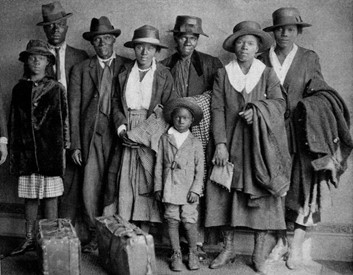
Introduction to Lesson 17
The continuation of the Great Black Migration just after World War II from Southern to Northern cities such as Chicago, Los Angeles, Philadelphia, and New York strengthened the flow of preserving African Americanisms between Southern and Northern Blacks. New arrivals who left an environment and society full of oppression and discriminatory actions in hopes of a better life brought their Southern way of life to these big cities. To say their transition was easy would be an understatement. The church was the cornerstone for the African American community for these new arrivals from the South, as well as those formerly from the South who were already immersed in the particularly favorable environment. The video below briefly tells the story of the Black Church as the foundation of African American culture.

The Black Church [ 00:00-00:00 ]
For this reason, religion and religious practices are some of the major factors that proved to be helpful to acclimate to this new environment. Hence the African American folk tradition of hymnody and early gospel, already discussed in Lesson 12, were familiar styles among Southern and Northern Blacks. In these bigger cities full of hope and promise, gospel music evolved further to its golden age.
Gospel music is a twentieth-century form of African American religious music that evolved in urban cities following the Great Migration of Blacks from the rural South in the period surrounding World Wars I and II. Although musicians had laid this genre's musical foundation in several different contexts in the first quarter of the twentieth century, it was not until the 1930s that the term gospel music and its repertoire and distinctive performance style gained widespread usage among Blacks across denominational lines.
Scholars consistently describe the urban storefront music of the 1930s by its delivery style or aesthetic features. Just as these small bodies' preaching and worship services reflected the continuation of a worship style that had distinguished independent Black churches in the rural South, the music expression was also consistent. While the repertoire included Protestant hymns and occasionally spirituals, it was often a new genre, sometimes referenced as gospel hymns and other times derisively referred to as jazz hymns, that became the hallmark of these congregations (Drake and Cayton 1962, 622, 670).
The following timeline shows the golden age of gospel relative to early gospel and contemporary gospel.
Three Major Phases of Gospel Music PDF
Below is a quick view of significant events during the golden age of gospel.
Chicago is the birthplace of early gospel music. Innovative contributions to the style from Thomas A. Dorsey, Mahalia Jackson, Sallie Martin, and others laid a foundation for the music to develop further. Many in Chicago viewed gospel music as more than religious music for the Black community. It was Chicagoan music, which was America's finest place for music. People also heard gospel at storefront (a church alongside various stores as a way to advertise its existence) Pentecostal churches in Harlem due to the Great Migration of African Americans in New York. For example, in 1938, at "...New York's Carnegie Hall...the brainchild of White music impresario John Hammond, "From Spirituals to Swing," was a cultural event with a social mission: to transform attitudes about race by displaying exemplars of Black musical achievement to an urban White audience" (Wald 2003, 387).
It's a Highway to Heaven
It's a highway to heaven
None can walk up there
But the pure in heart
It's a highway to heaven
Walking up the king's highway
Precious Lord
Through the storm, through the night
Lead me on to the light
Take my hand precious Lord, lead me home







